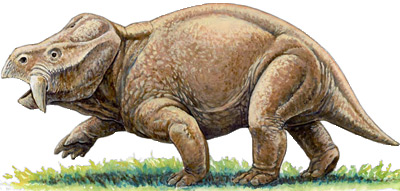
|
Search JoyZine with Google Site Search! |
Dicynodonts
Dicynodonts are a kind of mammal-like reptile, part of a group called therapsids. This ancient hippo-like reptile, extinct elsewhere, existed in Australia for another 110 million years—alongside the dinosaurs that wiped them out in other places, palaeontologists have found. This animal should not be living alongside our Cretaceous dinosaurs. But in 2003, scientists took a closer look at pieces of a fossil skull that had been stored in the Queensland Museum for nearly ninety years. It had been collected from rocks near Hughenden in Queensland dated at 105 million years old. The six fragments of the left side of a skull were identified as dicynodont. The skull fragments show clear signs of the characteristic tusks and the unusual beak. Dinosaurs became extinct 65 million years ago, which is less than the 105 million years between the time when dicynodonts were believed to have disappeared and the dating of this new Australian specimen. They were mostly about the size of a sheep or a pig, about 1m high. It had front legs that sprawled sideways like a lizard’s, but had back legs that were straight and looked more like the legs of a mammal. They had barrel-shaped bodies and large heads with two small, downward-pointing tusks and a blunt beak like a tortoise. We don’t know if they had fur, but their fossils have a single hole in the side of the skull behind the eye socket that is typical of mammals. Also the way that their back legs are located directly beneath their body instead of splaying out sideways is also more like a mammal than a reptile. The name dicynodont means ‘two dog teeth’ and was given to them because their tusks are like canine teeth, or dog teeth. Some species of dicynodont have obvious differences between the males and females (the males have tusks and the females don’t), which again is more like mammals than reptiles. However, most of the skeleton of a dicynodont is more like a reptile’s than a mammal’s. |
